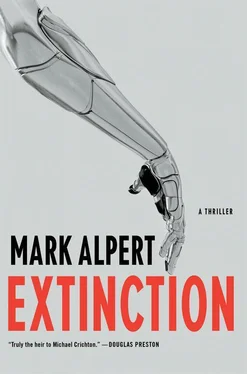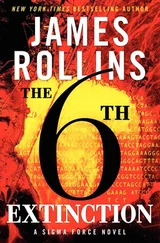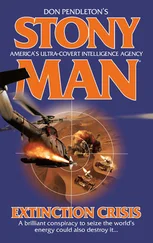“Of course. It’s a harmful piece of software hidden in a computer system.”
“Right, it’s usually software. People are tricked into loading the harmful program into their machines because it looks legitimate. Then the Trojan can delete their files or steal their data. But a Trojan can also be inserted into the hardware. If a hacker has access to a chip-design facility or a factory that makes computer equipment, he can slightly alter a few of the circuits imprinted in a microprocessor.”
“And what’s the advantage of doing that?”
“Well, you can usually detect a software Trojan if you run a diagnostic on your system. But there are billions of microscopic wires and transistors in a processor. If you rerouted the wiring in just a few places, the alteration would be virtually undetectable. The processor would function normally and the user wouldn’t suspect a thing until the Trojan was activated.”
Kirsten cocked her head. Her glasses reflected the white rectangle of the sat phone’s screen. “Yeah, I heard something about this,” she said. “Weren’t there rumors a few years ago that the Israelis slipped a compromised chip into Syria’s radar system?”
Jim nodded. “That’s right. The chip turned off the radar just before the Israeli Air Force flew a bombing raid against a Syrian nuclear plant. The way it works is that the hacker waits until the right moment, then sends a specific code to the system. The code trips the altered circuit in the computer chip and initiates a new set of instructions. It could order the computer to erase every file in its memory. Or it could simply shut down the system.”
Kirsten paused, thinking. She raised her right hand to her chin. “So did Arvin put a Trojan in the processors of his implants?”
Jim nodded again. “He said he hid a shutdown switch in the circuitry. And there’s a code for activating it, a shutdown code, but it’s a little unusual. The code is incorporated into an image. Arvin’s exact words were, ‘It will turn them to stone.’ He meant that if a Module saw this image, the code would shut down its retinal implants and break its connection to Supreme Harmony.”
“Wait a second. How could that happen?”
“When a Module views the image, his retinal implants convert it to a stream of data, millions of zeroes and ones. And Arvin designed the image so that the stream contains the shutdown code, a particular sequence of zeroes and ones buried somewhere within the data. When this sequence passes through the implant’s processor, it trips the altered circuit and disables the chip.”
Kirsten gave him a skeptical look, pursing her lips and lowering her eyebrows. “And did Arvin show you this image?”
“No, but I found it in his visual memories. It’s a picture of Medusa, from Greek mythology. Arvin liked the symbolism, I guess.” He held up the satellite phone. “I downloaded it into my phone, but I’m not going to show it to you. I’m afraid it might shut down your implants, too.”
She still looked skeptical. She didn’t say anything for a while, and the silence of the Fangshan tunnel settled over them. Jim didn’t like this silence. It was heavy, oppressive. It was, literally, the silence of the grave.
Finally, Kirsten let out a sigh. “Are you sure about this, Jim? It seems like a convoluted way to deliver the shutdown code. Wouldn’t it be easier to just transmit the code wirelessly to the network?”
“That wouldn’t work. Supreme Harmony probably has a heavy-duty firewall that would filter out any suspicious transmissions from outside the network. But Arvin’s shutdown code is designed to go under the firewall. It slips through the network’s defenses by pretending to be just another piece of visual information for the Modules to process and analyze.”
She shook her head. “I don’t know. Even if you’re right, I don’t see how this can help us. Let’s say the Medusa image can shut down the implants. Can you really use it to take down the network? Are you going to walk up to the Modules with that picture in your hand and say, ‘Hey, guys, take a look at this’?”
“No, that wouldn’t work either. According to Arvin’s memories, showing Medusa to one of the Modules will disable its implants before it can share the image with the rest of Supreme Harmony. To shut down the whole network, we have to disconnect every Module. So we need to deliver the shutdown code to all of them at once.”
“And how the hell are you gonna do that?”
Jim didn’t have an answer. He hadn’t thought that far ahead yet. He wanted to say something to convince Kirsten that he knew what he was doing, that they had at least a slim chance of defeating Supreme Harmony. But, instead, he just stood there, biting his lip, and the tunnel’s silence settled over them again.
And then, just as the silence was becoming unbearable, Jim heard something. It was a low, familiar buzzing, echoing down the tunnel from the direction of central Beijing.
Supreme Harmony observed the bed where Franklin B. Nash’s mangled body lay. The sheets were dark red, soaked with his blood. Before revealing the location of Arvin Conway’s flash drive, Nash had endured forty-seven minutes of interrogation, which was far longer than the network had predicted. Given that Nash was merely Conway’s employee, Supreme Harmony hadn’t expected him to show such loyalty. Had Nash realized, perhaps, that the network would kill him anyway as soon as he gave up his secret? So he’d resisted the questions and endured the torture simply to stay alive for a few minutes longer? It was impossible to know. In some cases, Supreme Harmony acknowledged, human behavior was inexplicable.
Modules 64 and 65 had already inspected the chamber in the Underground City where Nash said he’d hidden the flash drive. Although they didn’t find the device, the Modules detected trace evidence—human hairs, clothing fibers, and footprints in the dust—indicating recent activity in that chamber and the nearby tunnels. Expanding their search, the Modules discovered tire tracks in the tunnels leading to the Changping and Fangshan districts. What’s more, the width of the tracks matched the width of the tires on the Baotian scooter pushed by Kirsten W. Chan in the surveillance video from Xidamo Hutong. The evidence suggested a solution to a puzzle that had been plaguing Supreme Harmony—how did James T. Pierce escape from the police helicopters searching for him in Changping? Now the network knew the answer.
Unfortunately, there was little information about the Underground City on the government’s servers. The digital archives held no maps of the abandoned tunnels, so Supreme Harmony had to rely on the surveillance of its Modules and drones. Over the past hour, the network had dispatched seventeen Modules to the Underground City, but their operations were slowed by the difficulty of establishing radio links in the tunnels. The Modules needed to install radio repeaters in the Fangshan tunnel before they could pursue Pierce and Chan. But the drones were capable of autonomous navigation. They could fly out of radio range and carry out preprogrammed instructions.
Supreme Harmony ordered a swarm of two thousand drones to fly to the end of the Fangshan tunnel. Their cameras were tuned to the infrared frequency band, and they were programmed to lock onto any target with a heat signature of 37 degrees Celsius—human body temperature. Given the average speed of the drones, they would reach their targets very soon.
Jim grabbed Kirsten by the waist and hoisted her up to the hole he’d dug in the earthen wall. She stretched her arms into the gap and struggled to get a handhold. Jim wished he’d widened the hole a few inches more, but it was too late for that now. He gave Kirsten a boost, planting his hands on her butt and literally shoving her into the wall. After a couple of seconds she managed to wriggle her head and shoulders into the gap. Then he grabbed her feet and positioned her heels on his shoulders so she could use her leg muscles to push herself forward. The buzzing of the drones grew louder and closer. The noise filled the tunnel, echoing off the concrete walls.
Читать дальше












